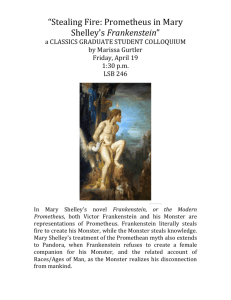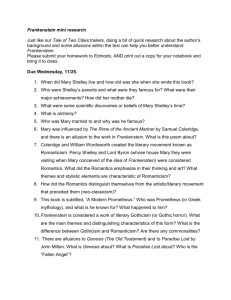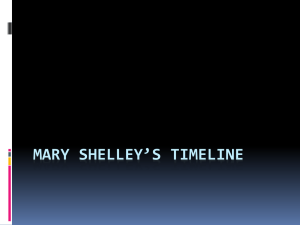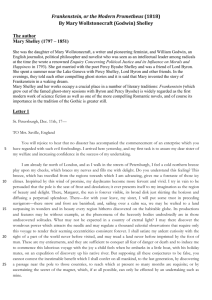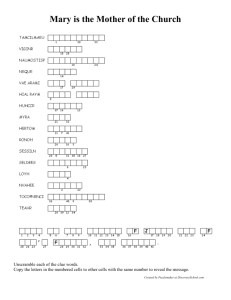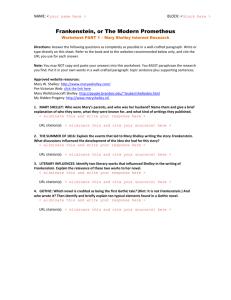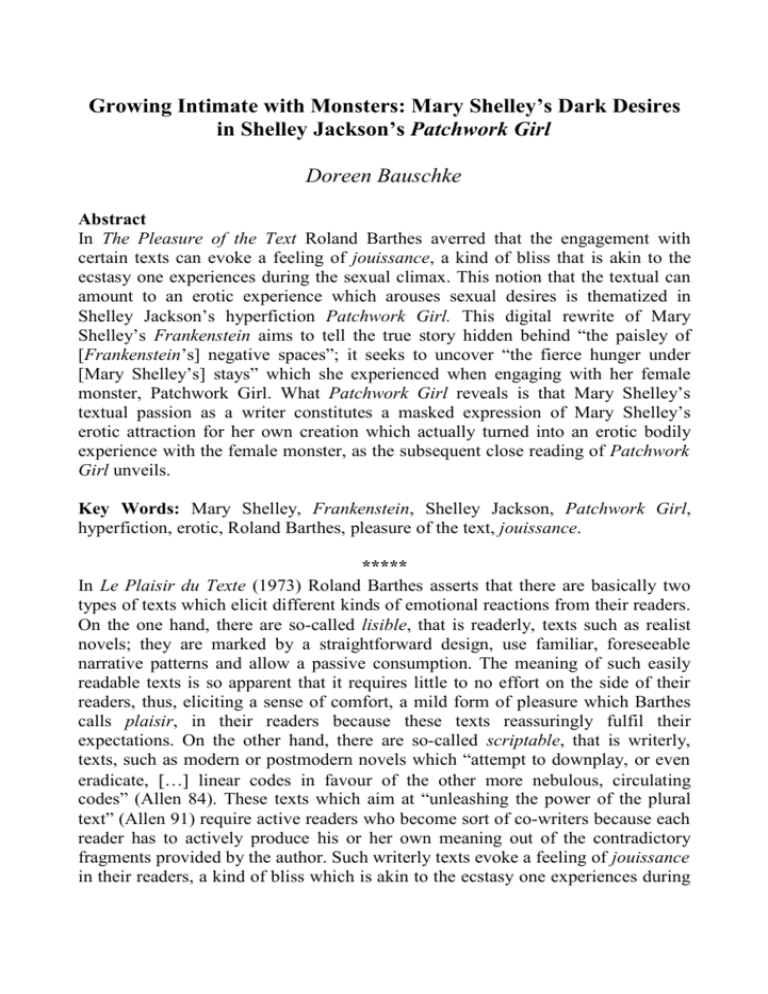
Growing Intimate with Monsters: Mary Shelley’s Dark Desires
in Shelley Jackson’s Patchwork Girl
Doreen Bauschke
Abstract
In The Pleasure of the Text Roland Barthes averred that the engagement with
certain texts can evoke a feeling of jouissance, a kind of bliss that is akin to the
ecstasy one experiences during the sexual climax. This notion that the textual can
amount to an erotic experience which arouses sexual desires is thematized in
Shelley Jackson’s hyperfiction Patchwork Girl. This digital rewrite of Mary
Shelley’s Frankenstein aims to tell the true story hidden behind “the paisley of
[Frankenstein’s] negative spaces”; it seeks to uncover “the fierce hunger under
[Mary Shelley’s] stays” which she experienced when engaging with her female
monster, Patchwork Girl. What Patchwork Girl reveals is that Mary Shelley’s
textual passion as a writer constitutes a masked expression of Mary Shelley’s
erotic attraction for her own creation which actually turned into an erotic bodily
experience with the female monster, as the subsequent close reading of Patchwork
Girl unveils.
Key Words: Mary Shelley, Frankenstein, Shelley Jackson, Patchwork Girl,
hyperfiction, erotic, Roland Barthes, pleasure of the text, jouissance.
*****
In Le Plaisir du Texte (1973) Roland Barthes asserts that there are basically two
types of texts which elicit different kinds of emotional reactions from their readers.
On the one hand, there are so-called lisible, that is readerly, texts such as realist
novels; they are marked by a straightforward design, use familiar, foreseeable
narrative patterns and allow a passive consumption. The meaning of such easily
readable texts is so apparent that it requires little to no effort on the side of their
readers, thus, eliciting a sense of comfort, a mild form of pleasure which Barthes
calls plaisir, in their readers because these texts reassuringly fulfil their
expectations. On the other hand, there are so-called scriptable, that is writerly,
texts, such as modern or postmodern novels which “attempt to downplay, or even
eradicate, […] linear codes in favour of the other more nebulous, circulating
codes” (Allen 84). These texts which aim at “unleashing the power of the plural
text” (Allen 91) require active readers who become sort of co-writers because each
reader has to actively produce his or her own meaning out of the contradictory
fragments provided by the author. Such writerly texts evoke a feeling of jouissance
in their readers, a kind of bliss which is akin to the ecstasy one experiences during
2
Growing Intimate with Monsters: Mary Shelley’s Dark Desires
__________________________________________________________________
the sexual climax, at least in those readers who delight in grappling with “the
plural of the demoniacal texture” (Barthes, “Work” 160), i.e. who enjoy a more
experimental unsettling reading experience.
Shelley Jackson’s hyperfiction Patchwork Girl belongs to this latter category of
texts. This electronic novel consists of a plethora of discrete narrative fragments
known as lexias that are connected through multiple links. Consequently, its
computerized text is not only multiple but also mutable, since each reader’s textual
experience depends entirely on the particular paths a reader chooses when reaching
one of its countless textual crossroads.
Yet, not merely the writerly structure of Patchwork Girl is related to Barthes’
notion of jouissance, but this idea that the textual can amount to an erotic
experience which arouses sexual desires is also thematized within its shifting
textual fragments. After all, the intertextual agenda of this digital rewrite of Mary
Shelley’s Frankenstein is to tell the true story hidden behind “the paisley of
[Frankenstein’s] negative spaces” (a story/ M/S/ she). 1 Concretely, it seeks to
uncover “the fierce hunger under [Mary Shelley’s] stays” (a story/ M/S/ she) which
the “proper” (a story/ M/S/ she) Mary Shelley suppressed when writing her Gothic
novel. These dark desires of Mary Shelley are revealed, above all, within one of
Patchwork Girl’s five main sections which is entitled “a journal.” It contains a
journal written by a fictive Mary Shelley that chronicles her creation of the female
monster in Frankenstein, which, as Jackson’s rewrite reveals, was actually
completed and lived, rather than being destroyed. Moreover, the main section “a
journal” describes the ensuing relationship between Mary and her monster.
Mary’s relation to the female creature in Patchwork Girl stands in implicit
contrast to the relation between Victor Frankenstein and the male monster (cf.
Glavanakova-Yaneva 68, 71-72, Hayles 34, Sánchez-Palencia and Almagro
Jiménez 121ff.). This is already hinted at within the second lexia of the section “a
journal”, where Mary while going for a solitary walk is suddenly waylaid by
Patchwork Girl:
It was my monster, stark naked, standing as still as if I [Mary] had
not yet breathed life into her massive frame, and waiting for me. She
held in one hand a scrap of cloth I recognized, all that was left of the
clothes I had thrust upon her when she fled me shortly after her
conception; the rest she had lost or cast aside. I could not help but
quail before the strangeness of this figure, from which, I fancifully
imagined, the very blades of grass seemed to shrink, but curiosity,
compassion, and a kind of fellow feeling was the stronger impulse,
and I forced myself to continue. (a journal/ sight, emphasis mine)
While in Frankenstein Victor feels loathing for his monster, which eventually
results in tragedy for both creator and creature, in Patchwork Girl Mary
Doreen Bauschke
3
__________________________________________________________________
predominantly feels sympathy rather than horror for her creation. However, what
initially appears as pity turns out to be admiration, as the lexia “she stood” reveals:
[…] She was stark naked. I noticed what I could not have seen in the
dim light of my laboratory, that the various sectors of her skin were
different hues and textures, no match perfect. Here a coarser texture
confused the ruddy hue of blood near under the skin, there smooth
skin betrayed a jaundiced undertone, there a dense coat of fine hairs
palely caught the light. Warm brown neighbored blue-veined ivory.
I thought of the tree that stands by the house. I have often noticed
that a length of cloth however richly dyed cannot match the beauty
or sustain the interest of Autumn foliage […, of its] myriad differing
hues […].
In this same way she was beautiful. (a journal/ she stood)
While Victor in Frankenstein never tires of pointing out the appalling hideousness
of the male monster, Mary sees beauty in the patched skin of the female creature,
which as a patchwork is capable of capturing the beauty of autumn foliage with its
myriad of different hues, which a single piece of cloth never could.
However, Mary’s feelings towards her creation are not entirely positive but
rather as “variegated” (a journal/ meeting) as her creation, as Mary emphasizes in
the next lexia, where she specifies that she feels “tenderness, repugnance, fear, and
profound responsibility, both anxious and prideful” (a journal/ meeting) towards
Patchwork Girl. The source of Mary’s ambivalent feelings for her female monster
is that Patchwork Girl arouses a “fierce hunger under her [Mary’s] stays” (a story/
M/S/ she) that terrifies Mary. What initially begins as a mother-child-relationship
between Mary and her brainchild, soon takes on another quality, as the lexia
“crave” suggests:
I crave her company; I crave even the danger. Do I yearn for the
easement of my own company? Do I resent the fierce mad engine
that is throbbing inside my serene life, staining my underclothes,
creasing my brow, making me jump up restless from Percy’s side to
go to my writing desk, the window, the bookcase, the door, while he
gazes at me in gentle reproach, or speaks to me as a tutor might of
the inner peace I clearly lack? Yes, of course I do. You are taking
me over, I long to cry, but does one punish the food for the pain in
one’s empty belly? (a journal/ crave, emphasis mine)
Evidently, Mary behaves like someone who is madly in love and craves nothing
more than the company of one’s object of affection. Mary’s initial sensuous artistic
4
Growing Intimate with Monsters: Mary Shelley’s Dark Desires
__________________________________________________________________
admiration of Patchwork Girl gradually becomes sensual desire, so that eventually
a love affair develops between them, as the following series of lexias chronicles:
Last night I lay in her arms, my monster, and for the first time laid
my hand on her skin. Her skins, I should rather say […] Her body
was warm. Feverish, I might say, yet knew not what internal
thermostat might hold steady and true in that preternaturally robust
form. […] (a journal/ scars/ I lay)
We turned this way and that, slipping at times into reverie,
approaching intimacy and veering away again by mutual and
emphatic agreement, feigning slumber and awakening. At last she
turned and looked at me and I saw a sort of desperation in her eyes.
Here at least she was still my child, and she would not move without
a sign from me. (a journal/ scars/ turned)
I moved my hand then, and touched one of her scars […] those
portions which her maker had stitched [… where] whitened tissue
divided her torso into sectors as distinct as patches in a quilt. (a
journal/ scars/ I moved)
I ran my fingertips along a seam that traversed her flank. It was
tough and knobbled, yet slick. And it was hot, not the cold I had
anticipated without knowing it. Indeed, it was hotter than the
stretches of smooth skin it divided, as I proved by caressing both
regions. […] (a journal/ scars/ fingertips)
[…] I clung to her with the full extent of my strength and the length
of my body, and she returned the embrace. Our hands hunted and
probed. We breathed each other's breath. Her scars lay like living
things between us, inscribing themselves in my skin. I thought I too
was rent and sewn, that I was both multiply estranged and gathered
together in a dynamic union.
What divided her, divided me. (a journal/ scars/ her, me)
Artistic admiration turns into erotic longing and this eventually leads to a sexual
relationship between Mary and Patchwork Girl. Barthes’ notion that the textual can
amount to an erotic experience which arouses sexual desires is evidently literalized
within Shelley Jackson’s hyperfiction Patchwork Girl, where Mary engages in
sexual relations with her textual creation.
Doreen Bauschke
5
__________________________________________________________________
As consequence of their sexual union, Mary comes to identify fully with her
monstrous creation, as the last lines of the ultimate quotation but also the following
passage underlines:
[…] I [Mary] wish I had her long strong limbs; I would run up these
Alps, as she tells me she does, following the changing light across
fields of ice. How quickly now our positions reverse and teacher
turns pupil! She has seen things I will never see; she remembers
more than I will experience in my whole life. And yet she is hungry
for more. I know she will leave me soon.
I have a crazy wish! I wish that I had cut off a part of me, something
Percy would not miss, but something dear to me, and given it to be a
part of her. I would live on in her, and she would know me as I
know myself. I fear this but crave it. I do not know if she would
want it. But I could graft myself to that mighty vine. Who knows
what strange new fruit the two of us might bear? (a journal/ female
trouble)
This lexia epitomizes that Mary ultimately perceives Patchwork Girl as a kind of
role model, whose hunger for life and resolution to satisfy that hunger is not only
admirable but also worth imitating, if one can muster the strength that Patchwork
Girl has. Due to this, Mary arduously desires to “graft” herself “to that mighty
vine” (a journal/ female trouble) of Patchwork Girl and exactly that is what she
does before her beloved monster leaves her and sets off to the New World; they
perform a special kind of surgery (a story/ M/S/ Mary) to commemorate each
other’s joining. The details of which are reported minutely in another main section
of the hyperfiction entitled “a story” which contains Patchwork Girl’s diary. In its
second subsection called “severance” Patchwork Girl writes on the day prior to her
departure to the United States:
I held her [Mary’s] leg steady as she unblinking scored a circle the
size of a farthing in the skin of her calf, then from the perimeter of
the circle toward the center slid the blade under the topmost layers
of skin, lifting it. I could see the dark metal through her fair skin.
‘Like detaching a round of pastry dough from a table top,’ she said,
lifting the bloody scrap whole on the tip of the blade and holding it
out toward me. I wiped the piece of skin off the blade onto a bit of
cotton and set the sharp edge of the knife against the knotty scar that
crosses my thigh to meet my groin. We had decided that as my skin
did not, strictly speaking, belong to me, the nearest thing to a bit of
my flesh would be this scar, a place where disparate things joined in
a way that was my own. For her part, she chose a piece of skin Percy
6
Growing Intimate with Monsters: Mary Shelley’s Dark Desires
__________________________________________________________________
would likely never miss, in a place where bandages could be readily
explained if they should be discovered.
I sliced off a disc of scar tissue the same size as the bit that lay on
the pink twist of cotton, and slid it off the point of the knife onto the
raw spot on her leg; she took the knife and laid her piece on me.
The needlework was her assignment; my big hands are too clumsy
for fine stitchery. I swabbed the blood from both our thighs. She was
pale but her hands were steady as she joined us. (a story/ severance/
join)
As Katherine Hayles also noted, “[t]his suturing of self onto other reveals more
than a wish of lovers to join. Because Mary is the monster’s creator in a double
sense, at once sewing and writing her, the scene functions as crossroads for the
traffic between fiction and metafiction […]” (Hayles 39). This skin graft is not
merely there to commemorate Mary’s and Patchwork Girl’s emotional and sexual
joining but it rather has a symbolic function that is intimately tied to the rethinking
of authorship in Patchwork Girl. After all, throughout the novel the physical body
comes to stand symbolically for the textual corpus, which is also the case here.
Yet, there are several layers of signification embedded in the skin graft episode.
One of these meanings is hinted at by the following passage:
[…] I [Patchwork Girl] do not know what came of that off-shoot of
me, if it dried and fell off or lived in its ring of scars. But I am a
strong vine. The graft took, the bit of skin is still a living pink, and
so I remember when I was Mary, and how I loved a monster, and
became one. I bring you my story, which is ours. (a story/ severance/
us, emphasis mine)
What is merely implied here is spelled out in another lexia which fleshes out this
scenario:
AM I MARY
I [Patchwork Girl] wonder if I am writing from my thigh, from the
crimp-edged pancakelet of skin we stitched onto me […]. Is my gift
a cutting of hers? Am I a host, phony, a setting for a gemstone? And
if so, is that good or bad? Maybe my crude strength and my techy
bent are better filters for her voice than her still-polite manners. Or
does her politesse make her criminal leanings steeper, more
vertiginous for the height of their drawing room origins? […]
Mary writes, I write, we write, but who is really writing? Ghost
writers are the only kind there are. (a story/ rethinking/ am i mary)
Doreen Bauschke
7
__________________________________________________________________
The usual denotation of the term ghost writer as someone who writes something
for somebody else and that person’s rather than the actual writer’s name will
appear on the book as author is extended ingeniously here. It is suggested in
Patchwork Girl that each process of text production consists of countless
individual acts of appropriation, since the language a writer uses is never his or her
own. Instead, each writer inevitably appropriates the words, the style, and other
narrative elements which have been used before, largely by writers and speakers
who are dead now. Thus, technically speaking, we all become ghost writers who
are possessed by the dead, and we all commit multiple acts of plagiarism when we
speak through this haunted language.
The skin graft episode cited earlier serves as a symbol for this collective form
of authorship which is not only thematized but also structurally embodied within
Shelley Jackson’s hyperfiction, since many of its textual snippets are appropriated
verbatim from a host of other fictional and non-fictional sources, one of them being
Mary Shelley’s Frankenstein. But there is still more to the skin graft and to this
reinterpretation of ghost-writing if we consider the following passage, where the
speaking I could either be interpreted as the title character Patchwork Girl or as the
computer novel Patchwork Girl:
Everything I'm [Patchwork Girl/Patchwork Girl] made of speaks up
from the dead. This language I speak, it's haunted. No, it is a
haunting, possession, an unfamiliar voice, dogs growling, in my
throat. Stuck succubus, I was going to say, because possession is as
sexual as it sounds. A haunting and sexual intercourse / discourse.
[…] (a story/ rethinking/ voices)
If one considers that the textual is presented as sexual within Patchwork Girl,
because engaging with words or discourse is equated with engaging in sexual
intercourse, then it is little surprising that this ‘haunting of language’ also entails
these sexual undertones. Yet, the result of such sexual-textual desires is dangerous
as another passage warns us: “When we have business with language, we are
possessed by its dreams and demons, we grow intimate with monsters. We become
hybrids, chimeras, centaurs ourselves: steaming flanks and solid redoubtable hoofs
galloping under a vaporous machinery” (body of text/ it thinks). When we relate
this quotation from Patchwork Girl to the plot of the main section “a journal” it
translates into the following: When Mary Shelley had “business with language”
while piecing and writing Patchwork Girl/Patchwork Girl, she became gradually
“possessed” by her demon quilt to the point of “grow[ing] intimate with [her]
monster.” However, this sexual-textual merging (cf. Shackelford 92) had serious
consequences for her, as a further lexia, which also serves as a warning to
Patchwork Girl’s reader’s, clarifies: “Keep in mind […] your skin is a permeable
membrane. […] Come closer, come even closer: if you touch me, your flesh is
8
Growing Intimate with Monsters: Mary Shelley’s Dark Desires
__________________________________________________________________
mixed with mine, and if you pull away, you may take some of me with you, and
leave a token behind” (a body of text/ hazy whole). Anyone who is possessed and
haunted, sexually and textually, ultimately turns into a “hybrid” and a “chimera”
her- or himself. Thus, the swapping of pieces of skin is meant to serve as a “solid”
reminder of Mary’s own monstrousness, which remained “vaporous” in
Frankenstein where Mary’s demonic streak could merely be “glimpsed in the
paisley of its negative spaces” (a story/ M/S/ she) but which was allowed to be
placed at the forefront in Patchwork Girl.
Notes
1
All subsequent references of the primary hypertext stem from Jackson, Shelley. Patchwork Girl. Watertown, MA: Eastgate
Systems, 1995.
Bibliography
Allen, Graham. Intertextuality. 2nd ed. London and New York: Routledge, 2011.
Barthes, Roland. “From Work to Text”. Image, Music and Text. New York: Hill and Wang, 1977.
Barthes, Roland. The Pleasure of the Text. Transl. by Richard Miller. New York: Hill and Wang, 1975.
Glavanakova-Yaneva, Alexandra. “Body Webs: Re/constructing Boundaries in Shelley Jackson’s Patchwork Girl”. Journal
Of American Studies of Turkey 18 (2003): 65-79.
Hayles, Katherine N. “Flickering Connectivities in Shelley Jackson's Patchwork Girl: The Importance of Media-Specific
Analysis”. Postmodern Culture 10.2 (2000): http://pmc.iath.virginia.edu/text-only/issue.100/10.2hayles.txt (accessed
October 31, 2012).
Jackson, Shelley. Patchwork Girl. Watertown, MA: Eastgate Systems, 1995.
Sánchez-Palencia Carazo, Carolina and Manuel Almagro Jiménez. “Gathering the Limbs of the Text in Shelley Jackson’s
Patchwork Girl”. ATLANTIS 28.1 (June 2006): 115-129.
Shackelford, Laura. “Subject to Change: The Monstrosity of Media in Shelley Jackson’s Patchwork Girl; or, A Modern
Monster and Other Posthumanist Critiques of the Instrumental”. Camera Obscura 21.3 (2006): 62-101.
Doreen Bauschke is an independent scholar at the Friedrich-Schiller-Universität in Jena, Germany. She has recently earned
a PhD in American literature with the dissertation entitled Quilt(ed) Texts: The Patchwork Quilt in Contemporary North
American Novels. Additionally to patchwork and quilts as literary phenomenon, she is interested in Gothic literature,
intertextuality, gender studies, early American drama and hyperfiction.


